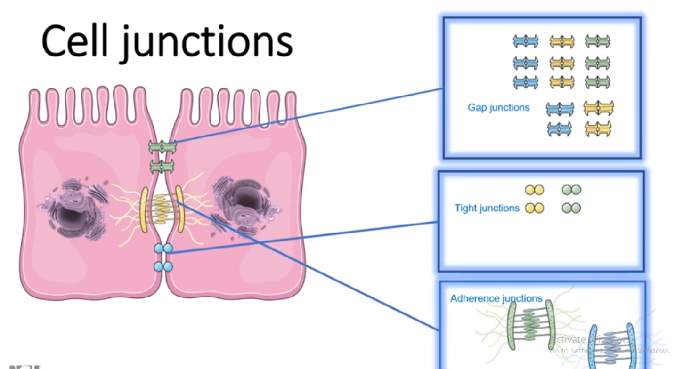Surface Modification of Cell Membrane & Junctional Complex
5 years ago 3456

| • Microvilli are the finger-like projections of the surface epithelium. |
| • Found in small intestine & Proximal convoluted tubules (termed as brush border) |
|
• Functions:
- Increase surface area for increasing the absorption.
(Characteristic feature of the lining epithelium of small intestine) |
| • They are the long, nonmotile processes like microvilli found in the apical surface of cells. |
| • Found in Epididymis & Hair cells of internal ear |
| • Elongated motile(movable) hair-like structures on the surface of the epithelial cells. |
| • Found in respiratory tract and genital tract. |
| • Like lining epithelium of respiratory tract → is Pseudo-stratified ciliated columnar epithelium |
| • Characteristic feature of Respiratory Tract |
| • Only found in spermatozoa |
|
• Helps in the mobility of spermatozoon within the female reproductive tract.
|
| Villi | Microvilli |
| • Villi are the finger-like or leaf-like projection of lamina propria(loose connective tissue beneath epithelium) covered by surface epithelium | • Microvilli are short finger-like projections of the cell membrane of the surface epithelium. |
| • It is composed of - loose connective tissue - lymphatic channels - Capillary - Diffused lymphoid tissue |
• It is composed of cytoplasm of surface epithelium |
| Cilia | Stereocilia |
| • Soft-movable Hair-like structure | • Quite rigid like non-movable processes |
| • Present in the respiratory tract, Genital tract | • Present in epididymis and hair cells of the internal ear. |
| • Cilia of the respiratory tract help to sweep the fluid from the respiratory tract & protect by eliminating bacteria & foreign particles. • Cilia helps in the movement of spermatozoa through the uterine tube and the male genital tract.
|
• Stereocilia of Hair cells help in signal transduction of auditory impulse. |
| The process by which macro-molecules are exported by cells to outside extracellular space. |
| • Intracellular vesicles contain materials (like neurotransmitters, enzymes, hormone) move towards the cell membrane, where vesicles fuse with the cell membrane, then the contents of vesicles are released outside. |
| Examples: - - Release of neurotransmitter in the synapse - Export of proteins from cells to blood. - Export of chylomicron by enterocytes to lymphatics |
| 1) Phagocytosis (cell eating): |
| It is the process by which bacteria, dead tissue, are engulfed by cells. The material makes contact with the cell membrane, which then invaginates inside the cell. |
| It is the process of ingestion/eating of substances visible under the microscope. |
| 2) Pinocytosis (cell drinking process): |
| It is the process of ingestion of substances not visible under the microscope. |
| It is quite the same as that of phagocytosis. The only difference is that substances ingested are in solution and not visible under the microscope. |
| During endocytosis, a portion of the cell membrane is used to form endocytotic vesicles by which macromolecules are transported inside the cell. |
| During exocytosis, secretory vesicles formed by the Golgi apparatus fused with the cell membrane and release their product to extracellular space. |
Comments (0)